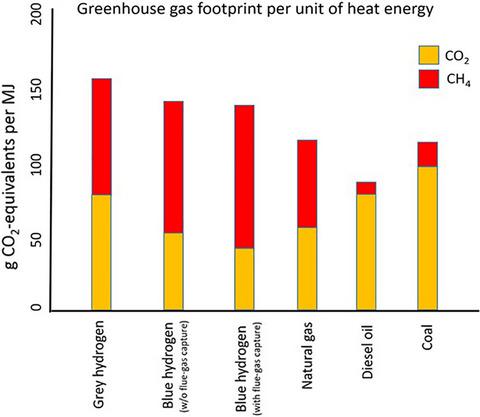当前位置:
X-MOL 学术
›
Energy Sci. Eng.
›
论文详情
Our official English website, www.x-mol.net, welcomes your feedback! (Note: you will need to create a separate account there.)
How green is blue hydrogen?
Energy Science & Engineering ( IF 3.5 ) Pub Date : 2021-08-12 , DOI: 10.1002/ese3.956 Robert W. Howarth 1 , Mark Z. Jacobson 2
Energy Science & Engineering ( IF 3.5 ) Pub Date : 2021-08-12 , DOI: 10.1002/ese3.956 Robert W. Howarth 1 , Mark Z. Jacobson 2
Affiliation

|
Hydrogen is often viewed as an important energy carrier in a future decarbonized world. Currently, most hydrogen is produced by steam reforming of methane in natural gas (“gray hydrogen”), with high carbon dioxide emissions. Increasingly, many propose using carbon capture and storage to reduce these emissions, producing so-called “blue hydrogen,” frequently promoted as low emissions. We undertake the first effort in a peer-reviewed paper to examine the lifecycle greenhouse gas emissions of blue hydrogen accounting for emissions of both carbon dioxide and unburned fugitive methane. Far from being low carbon, greenhouse gas emissions from the production of blue hydrogen are quite high, particularly due to the release of fugitive methane. For our default assumptions (3.5% emission rate of methane from natural gas and a 20-year global warming potential), total carbon dioxide equivalent emissions for blue hydrogen are only 9%-12% less than for gray hydrogen. While carbon dioxide emissions are lower, fugitive methane emissions for blue hydrogen are higher than for gray hydrogen because of an increased use of natural gas to power the carbon capture. Perhaps surprisingly, the greenhouse gas footprint of blue hydrogen is more than 20% greater than burning natural gas or coal for heat and some 60% greater than burning diesel oil for heat, again with our default assumptions. In a sensitivity analysis in which the methane emission rate from natural gas is reduced to a low value of 1.54%, greenhouse gas emissions from blue hydrogen are still greater than from simply burning natural gas, and are only 18%-25% less than for gray hydrogen. Our analysis assumes that captured carbon dioxide can be stored indefinitely, an optimistic and unproven assumption. Even if true though, the use of blue hydrogen appears difficult to justify on climate grounds.
中文翻译:

蓝氢有多绿?
氢通常被视为未来脱碳世界的重要能源载体。目前,大多数氢气是通过天然气中甲烷(“灰氢”)的蒸汽重整生产的,二氧化碳排放量很高。越来越多的人建议使用碳捕获和储存来减少这些排放,生产所谓的“蓝色氢”,经常被宣传为低排放。我们在同行评议论文中首次尝试研究蓝色氢的生命周期温室气体排放,其中包括二氧化碳和未燃烧的逸散甲烷的排放。蓝氢生产的温室气体排放量远非低碳,而是相当高,特别是由于释放了易挥发的甲烷。对于我们的默认假设(3。5% 的天然气甲烷排放率和 20 年的全球变暖潜势),蓝氢的二氧化碳当量总排放量仅比灰氢少 9%-12%。虽然二氧化碳排放量较低,但蓝色氢气的逸散甲烷排放量高于灰色氢气,因为越来越多地使用天然气来为碳捕获提供动力。也许令人惊讶的是,蓝色氢的温室气体足迹比燃烧天然气或煤炭取暖多 20% 以上,比燃烧柴油取暖多 60% 左右,这也是我们的默认假设。在将天然气的甲烷排放率降低到 1.54% 的低值的敏感性分析中,蓝氢的温室气体排放量仍然大于简单燃烧天然气的温室气体排放量,并且仅比灰氢少 18%-25%。我们的分析假设捕获的二氧化碳可以无限期储存,这是一个乐观且未经证实的假设。即使如此,从气候角度来看,使用蓝色氢似乎也难以证明是合理的。
更新日期:2021-10-03
中文翻译:

蓝氢有多绿?
氢通常被视为未来脱碳世界的重要能源载体。目前,大多数氢气是通过天然气中甲烷(“灰氢”)的蒸汽重整生产的,二氧化碳排放量很高。越来越多的人建议使用碳捕获和储存来减少这些排放,生产所谓的“蓝色氢”,经常被宣传为低排放。我们在同行评议论文中首次尝试研究蓝色氢的生命周期温室气体排放,其中包括二氧化碳和未燃烧的逸散甲烷的排放。蓝氢生产的温室气体排放量远非低碳,而是相当高,特别是由于释放了易挥发的甲烷。对于我们的默认假设(3。5% 的天然气甲烷排放率和 20 年的全球变暖潜势),蓝氢的二氧化碳当量总排放量仅比灰氢少 9%-12%。虽然二氧化碳排放量较低,但蓝色氢气的逸散甲烷排放量高于灰色氢气,因为越来越多地使用天然气来为碳捕获提供动力。也许令人惊讶的是,蓝色氢的温室气体足迹比燃烧天然气或煤炭取暖多 20% 以上,比燃烧柴油取暖多 60% 左右,这也是我们的默认假设。在将天然气的甲烷排放率降低到 1.54% 的低值的敏感性分析中,蓝氢的温室气体排放量仍然大于简单燃烧天然气的温室气体排放量,并且仅比灰氢少 18%-25%。我们的分析假设捕获的二氧化碳可以无限期储存,这是一个乐观且未经证实的假设。即使如此,从气候角度来看,使用蓝色氢似乎也难以证明是合理的。







































 京公网安备 11010802027423号
京公网安备 11010802027423号